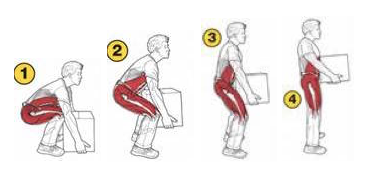Completing tasks that require heavy lifting, repetitive stress, bending and twisting, and pushing/pulling increase the risk of developing lower back pain. Poor posture, age, medical conditions, body weight, smoking, and exercise habits may also play a role.
- If available, use equipment (e.g. cart, hand truck) to move the object that are heavy or need to travel a long distance.
- Assess the object’s weight. If the object is too heavy or bulky, ask a coworker for help
- If possible, disassemble larger objects into smaller, more manageable parts
- Ensure a safe path free of debris, obstacles, and stairs.
- Ensure a clear line of vision when carrying objects.
- Best practice examples
- Take frequent breaks to interrupt repetitive lifting, mix in tasks that do not involve lifting, and take breaks to stretch.
- Use a stool or ladder to reach loads above your shoulders. Get as close to the load as possible before sliding it towards you. Work with your arms and legs — not your back.
- Take extra care with loads under racks or cabinets. Pull the load towards you, try to support the load on one knee before you lift, and use your legs to power the lift.
- Slide objects instead of lifting and carrying them.
- Push objects instead of pulling them.
- Plan tasks ahead of time to limit lifting and moving.
- Use hand trucks and push carts to assist with moving objects. For extremely heavy items, call on an authorized forklift operator.
- Design your workstation to avoid excessive bending, twisting, and stretching. Use tool supports for prolonged tool use.
The Safe Lifting/Handling Equipment Reimbursement Fund Program is intended to provide a training incentive in the form of up to 50% partial reimbursement for the purchase of pre-approved equipment that is designed to improve lifting/manual handling safety. For more information on the program and how to apply, see the Safe Lifting Reimbursement Fund Application.
Lifting and Handling Guidelines
Follow safe lifting biomechanics outlined in this video


Move your feet to reduce trunk rotation. Keep your “nose between your toes”
- Stand close with your feet shoulder width apart and face the object
- Bend your knees, keep your back straight and look forward
- Lift with your legs
- Keep items close to your body and at waist height
